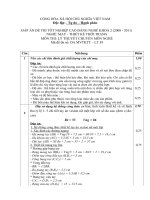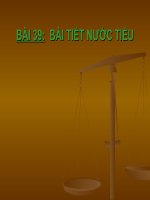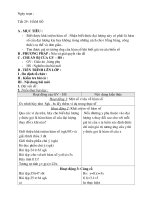PASSAGE 39
Bạn đang xem bản rút gọn của tài liệu. Xem và tải ngay bản đầy đủ của tài liệu tại đây (65.91 KB, 4 trang )
PASSAGE 39
Duncan Phyfe made some of the most beautiful furniture found in America. His family name was
originally Fife, and he was born in Scotland in 1768. In 1784, the Fife family immigrated to Albany, New
York where Duncan’s father opened a cabinetmaking shop. Duncan followed his father’s footsteps and
was apprenticed to a cabinetmaker. After completing his training, Duncan moved to New York City.
Duncan Fife was first mentioned in the 1792 NYC Directory as a furniture “joiner” in business at 2
Broad Street. Two years later, he moved, expanded his business, and changed his name to Phyfe. He was
a quiet-living, God-fearing young man who felt his new name would probably appeal to potential
customers who were definitely anti-British in this post-Revolutionary War period.
Duncan Phyfe’s name distinguished him from his contemporaries. Although the new spelling helped
him better compete with French emigrant craftsmen, his new name had more to do with hanging it on a
sign over his door stoop.
The artisans and merchants who came to America discovered a unique kind of freedom. They were no
longer restricted by class and guild traditions of Europe. For the first time in history, a man learned that
by working hard, he could build his business based on his own name and reputation and quality of work.
Phyfe’s workshop apparently took off immediately. At the peak of his success, Phyfe employed 100
craftsmen. Some economic historians point to Phyfe as having employed division of labor and an
assembly line. What his workshop produced shows Phyfe’s absolute dedication to quality in
workmanship. Each piece of furniture was made of the best available materials. He was reported to have
paid $1,000 for a single Santo Domingo mahogany log.
Phyfe did not create new designs. Rather, he borrowed from a broad range of the period’s classical
styles, Empire, Sheraton, Regency, and French Classical among them. Nevertheless, Phyfe’s high quality
craftsmanship established him as America’s patriotic interpreter of European design in the late eighteenth
and early nineteenth centuries.
Although the number of pieces produced by Duncan Phyfe’s workshop is enormous, comparatively
few marked or labeled pieces have been found extant. In antiques shops and auctions, collectors have paid
$11,000 for a card table, $24,200 for a tea table, and $93,500 for a sewing table.
Question 1. What is the main idea of the passage?
A. The business of cabinetmaking.
B. The significance of Duncan Phyfe’s name.
C. Duncan Phyfe’s life and career.
D. Duncan Phyfe’s cabinetmaking designs.
Question 2. According to the passage, which of the following does the author imply?
A. Duncan Fife and his father had the same first name.
B. Duncan Fife worked for his father in Scotland.
C. Duncan Fife and his father were in the same business.
D. Duncan Phyfe made over 100 different kinds of tables.
Question 3. Which choice does the word “it” in paragraph 3 refer to?
A. His spelling
B. His chair
C. His French
D. His name
Question 4. Which choice is closest in meaning to the word “guild” in paragraph 4?
A. Verdict of a jury
B. Organization of craftsmen
C. Political party of emigrants
D. Immigrants’ club
Question 5. In his business, Duncan Phyfe used all of the following EXCEPT ______.
A. division of labor
B. an assembly line
C. continental designs
D. the least expensive materials
Question 6. Based on the information in the passage, what can be inferred about Duncan Phyfe’s death?
A. He died in the eighteenth century.
B. He died in Albany.
C. He died in the nineteenth century.
D. He died in Scotland.
Question 7. The author implies that ______.
A. furniture from Duncan Phyfe’s workshop no longer exists.
B. furniture from Duncan Phyfe’s workshop costs a lot of money today.
C. furniture from Duncan Phyfe’s workshop was ignored by New Yorkers.
D. furniture from Duncan Phyfe’s workshop was made by his father.
ĐÁP ÁN
1-C
2-C
6-C
7-B
3-D
4-B
5-D
LỜI GIẢI CHI TIẾT
Question 1:
Đâu là ý chính của đoạn văn?
A. Việc kinh doanh ngành đồ gỗ mỹ nghệ.
B. Ý nghĩa của cái tên Duncan Phyfe.
C. Cuộc đời và sự nghiệp của Duncan Phyfe.
D. Việc thiết kế đồ gỗ mỹ nghệ của D. Duncan Phyfe.
Giải thích: Xun suốt tồn bài đều nói về Duncan Phyfe trên khía cạnh cuộc đời và sự nghiệp làm đồ nội
thất của ông.
Một số dẫn chứng như:
+ “he was born in Scotland in 1768. In 1784, the Fife family immigrated to Albany, New York where
Duncan’s father opened a cabinetmaking shop. Duncan followed his father’s footsteps and was
apprenticed to a cabinetmaker” – (Ông được sinh ra ở Scotland vào năm 1768, gia đình ơng nhập cư vào
Albany, New York- nơi mà cha ông mở một cửa hàng đồ gỗ mĩ nghệ. Duncan đã nối gót cha và theo học
nghề đồ gỗ mĩ nghệ).
+ “Two years later, he moved, expanded his business, and changed his name to Phyfe” – (2 năm sau, ông
rời đi và mở rộng việc kinh doanh, đổi tên thành Phyfe”.
+ “At the peak of his success, Phyfe employed 100 craftsmen” – (Vào thời kì đỉnh cao của thành công,
Phyfe đã thuê về 100 thợ thủ công).
Question 2:
Theo như đoạn văn, tác giả ám chỉ điều nào sau đây?
A. Duncan Fife và cha của ơng có cùng tên riêng.
B. Duncan Fife làm việc cho cha ông ở Scotland.
C. Duncan Fife và cha ơng ta cũng có cùng sự nghiệp kinh doanh giống nhau.
D. Duncan Phyfe đã chế tác ra trên 100 loại bàn khác nhau.
Dẫn chứng ở đoạn 1: “Duncan followed his father’s footsteps and was apprenticed to a cabinetmaker” –
(Duncan đã nối gót cha và theo học nghề đồ gỗ mĩ nghệ).
Question 3:
Từ “it” ở đoạn 3 đề cập tới.
A. cách đánh vần.
B. chiếc ghế.
C. tiếng Pháp.
D. tên.
Đọc cả câu chứ “it”: “Although the new spelling helped him better compete with French emigrant
craftsmen, his new name had more to do with hanging it on a sign over his door stoop” – (Mặc dù phát
âm mới đã giúp ông cạnh tranh tốt hơn với các thợ thủ công nhập cư người Pháp, nhưng cái tên mới mới
có nhiều điều đáng để nói và nó được khắc thành một dấu hiệu ở trên cái chặn cửa).
Question 4:
Câu hỏi từ vựng.
Từ “guild” ở đoạn 2 đồng nghĩa với?
A. Lời phán quyết của bồi thẩm đồn
B. Tổ chức của những người thợ thủ cơng.
C. Đảng chính trị của những người nhập cư
D. Câu lạc bộ những người nhập cư.
Guild (n): phường, hội, tập thể, tổ chức.
Các đáp án A, C, D khơng có nội dung liên quan .
Tạm dịch: “They were no longer restricted by class and guild traditions of Europe” – (Họ khơng cịn bị
giới hạn, cấm đoán bởi những tầng lớp hay tổ chức truyền thống của Châu Âu).
Question 5:
Trong sự nghiệp của mình, Duncan Phyfe đã sử dụng tới tất cả những điều sau đây, NGOẠI TRỪ______.
A. sự phân chia lực lượng lao động.
B. dây chuyền lắp ráp.
C. những thiết kế nội địa.
D. những vật liệu ít tốn kém nhất.
Các dẫn chứng A, B, C được tìm thấy trong bài:
+ Đoạn 5: “At the peak of his success, Phyfe employed 100 craftsmen. Some economic historians point to
Phyfe as having employed division of labor (A) and an assembly line (B)” – (Vào thời kì đỉnh cao của
thành cơng, Phyfe đã th về 100 thợ thủ công. Một số nhà sử gia kinh tế đã chỉ ra rằng Phyfe đã áp dụng
sự phân công lao động và một dây chuyền lắp ráp).
+ Đoạn 6 – (C): “Phyfe did not create new designs. Rather, he borrowed from a broad range of the
period’s classical styles, Empire, Sheraton, Regency, and French Classical among them ” – (Phyfe khơng
tạo ra những thiết kế mới. Thay vào đó, ơng vay mượn từ một loạt các phong cách cổ điển của các thời
kỳ, Empire, Sheraton, Regency, và Pháp cổ điển trong số đó).
Ngồi ra cũng có dẫn chứng chứng minh D sai, nằm ở đoạn 5: “Each piece of furniture was made of the
best available materials. He was reported to have paid \(1,000 for a single Santo Domingo mahogany
log” – (Từng phần của đồ nột thất được làm từ những chất liệu có sẵn tốt thất. Ơng được cho là đã chi ra
1000 đô cho một khúc gỗ gụ Santo Domingo).
Question 6:
Dựa vào thơng tin có trong đoạn văn, có thể suy ra được điều gì từ cái chết của Duncan Phyfe?
A. Ông qua đời vào thế kỉ 18.
B. Ông qua đời ở Albany.
C. Ông qua đời vào thế kỉ 19.
D. Ơng qua đời ở Scotland.
Giải thích:
Trong đoạn văn không đề cập trực tiếp tới thời gian và địa điểm qua đời của Phyfe, nên ta cần suy ta từ
những dữ kiện có trong bài.
+ Đoạn đầu tiên: “he was born in Scotland in 1768” – (Ông được sinh ra ở Scotland vào năm 1768).
+ Cuối đoạn 5: “Nevertheless, Phyfe’s high quality craftsmanship established him as America’s patriotic
interpreter of European design in the late eighteenth and early nineteenth centuries” – (Mặc dù vậy, sự
nghiệp đồ thủ công mĩ nghệ chất lượng cao của Phyfe đã giúp ông trở thành thông dịch ái quốc của Mĩ về
thiết kế Châu Âu và cuối thế kỉ 18 và đầu thế kỉ 19).
=> Ơng sống ít nhất qua đầu thế kỉ 19, nhưng khơng thể sống được tới thế kỉ 20 (vì nếu tới thế kỉ 20 là
ơng hơn 130 tuổi) =>Ơng mất vào thế kỉ 19.
Question 7:
Tác giả ám chỉ rằng ______.
A. đồ nột thất từ xưởng của Duncan Phyfe không còn tồn tại.
B. đồ nột thất từ xưởng của Duncan Phyfe có giá rất cao ngày nay.
C. đồ nột thất từ xưởng của Duncan Phyfe bị người dân New York ngó lơ.
D. đồ nột thất từ xưởng của Duncan Phyfe được làm ra bởi cha của ông.
Dẫn chứng ở câu cuối cùng: “In antiques shops and auctions, collectors have paid, 11,000 for a card
table, 24,200 for a tea table, and (93,500 for a sewing table” – (Trong các cửa hàng bán đồ cổ và những
cuộc đấu giá, có những nhà sưu tầm đã trả 11.000 đô la cho một chiếc bàn đánh bài, 24.200 đô la cho một
chiếc bàn trà và 93.500 đô la cho một chiếc bàn mây) => giá trị những đồ nội thất được làm ra từ xưởng
của Phyfe ngày nay có giá rất cao .









